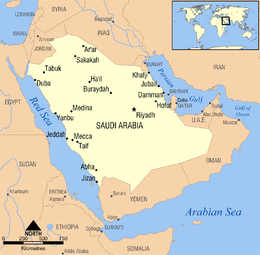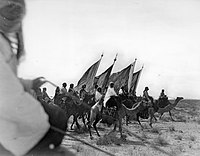
The history of Saudi Arabia as a nation state began with the emergence of the Al Saud dynasty in central Arabia in 1727 and the subsequent establishment of the Emirate of Diriyah. Pre-Islamic Arabia, the territory that constitutes modern Saudi Arabia, was the site of several ancient cultures and civilizations; the prehistory of Saudi Arabia shows some of the earliest traces of human activity in the world.

Najd is the central region of Saudi Arabia, in which about a third of the country's modern population resides. It is the home of the House of Saud, from which it pursued unification with Hejaz since the time of the Emirate of Diriyah.

Abdulaziz bin Abdul Rahman Al Saud, known in the West as Ibn Saud, was an Arab political and religious leader who founded Saudi Arabia – the third Saudi state – and reigned as its first king from 23 September 1932 until his death in 1953. He had ruled parts of the kingdom since 1902, having previously been Emir, Sultan, and King of Nejd, and King of Hejaz.

Abdul Rahman bin Faisal Al Saud was the last emir of Nejd, reigning from 1875 to 1876 and from 1889 to 1891. He was the youngest son of Emir Faisal bin Turki bin Abdullah and the father of Abdulaziz, the founder of the Kingdom of Saudi Arabia.

The Rashidi dynasty, also called Al Rashid or the House of Rashid, was a historic Arabian House or dynasty that existed in the Arabian Peninsula between 1836 and 1921. Its members were rulers of the Emirate of Ha'il and the most formidable enemies of the House of Saud, rulers of the Emirate of Nejd. They were centered in Ha'il, a city in northern Najd that derived its wealth from being on the route of the Hajj pilgrimage to Mecca, and was also a commercial center. The rulers of Ha'il were the sons of Abdullah bin Rashid, founder of the dynasty.

The tribe of Shammar is a tribal Arab Qahtanite confederation, descended from the Tayy, which migrated into the northern Arabian Peninsula from Yemen in the second century. It is the largest branch of the Tayy, and one of the largest and most influential Arab tribes. The historical and traditional seat of the tribe's leadership is in the city of Ḥaʼil in what was the Emirate of Jabal Shammar in what is now Saudi Arabia. In its "golden age", around 1850, the Shammar ruled much of central and northern Arabia from Riyadh to the frontiers of Syria and the vast area of Upper Mesopotamia.

The Ikhwan, commonly known as Ikhwan man ata'a Allah, was a religious militia made up of traditionally nomadic tribesmen which formed a significant military force of the ruler Ibn Saud and played an important role in establishing him as ruler of most of the Arabian Peninsula in the Kingdom of Saudi Arabia.

The Emirate of Nejd or Imamate of Nejd was the Second Saudi State, existing between 1824 and 1891 in Nejd, the regions of Riyadh and Ha'il of what is now Saudi Arabia. Saudi rule was restored to central and eastern Arabia after the Emirate of Diriyah, the First Saudi State, having previously been brought down by the Ottoman Empire's Egypt Eyalet in the Ottoman–Wahhabi War (1811–1818).

The Third Saudi state is the heir to the two earlier Saudi states: the first and the second, founded by Abdul Aziz bin Abdul Rahman, who managed to capture the city of Riyadh on January 13, 1902. A long series of conflicts and conquests ultimately led to the establishment of the modern and contemporary Saudi state, the Kingdom of Saudi Arabia.

The Ikhwan revolt was an uprising in the Arabian Peninsula from 1927 to 1930 led by the Ikhwan. It began in 1927, when the tribesmen of the Otaibah, Mutayr and Ajman rebelled against the authority of Ibn Saud and engaged in cross-border raids into parts of Transjordan, Mandatory Iraq and the Sheikhdom of Kuwait. The relationship between the House of Saud and the Ikhwan deteriorated into an open bloody feud in December 1928. The main instigators of the rebellion were defeated in the Battle of Sabilla, on 29 March 1929. Ikhwan tribesmen and troops loyal to Abdulaziz clashed again in the Jabal Shammar region in August 1929, and Ikhwan tribesmen attacked the Awazim tribe on 5 October 1929. Faisal Al Dawish, the main leader of the rebellion and the Mutair tribe, fled to Kuwait in October 1929 before being detained by the British and handed over to Ibn Saud. Faisal Al-Dawish would die in Riyadh on 3 October 1931 from what appears to have been a heart condition. Government troops had finally suppressed the rebellion on 10 January 1930, when other Ikhwan rebel leaders surrendered to the British. In the aftermath, the Ikhwan leadership was slain, and the remains were eventually incorporated into regular Saudi units. Sultan bin Bajad, one of the three main Ikhwan leaders, was killed in 1931, while Al Dawish died in prison in Riyadh on 3 October 1931.

The Emirate of Jabal Shammar, also known as the Emirate of Haʾil or the Rashidi Emirate, was a state in the northern part of the Arabian Peninsula, including Najd, existing from the mid-nineteenth century to 1921. Jabal Shammar in English is translated as the "Mountain of the Shammar". Jabal Shammar's capital was Ha'il. It was led by the monarchy of the Rashidi dynasty. It included parts of modern-day Saudi Arabia, Iraq, and Jordan.
The First Saudi–Hashemite War, also known as the First Nejd–Hejaz War or the al-Khurma dispute, took place in 1918–19 between Abdulaziz Ibn Saud of the Emirate of Nejd and Hasa and the Hashemites of the Kingdom of Hejaz.

The Ottoman era in the history of Arabia lasted from 1517 to 1918. The Ottoman degree of control over these lands varied over these four centuries, with the fluctuating strength or weakness of the Empire's central authority.
Abdullah bin Ali Al Rashid (1788–1848) was the founder of the Emirate of Jabal Shammar. He founded the Emirate in 1836 and ruled it until 1848. He was called Sheikh due to his noble lineage and military ability.
The Kuwaiti–Rashidi war was a conflict between the Sheikhdom of Kuwait and the Emirate of Jabal Shammar which was fought from 1900 to 1901. It began in mid-December 1900, when the emir of Kuwait, Mubarak Al-Sabah launched a raid into central Arabia. It saw moderate initial success, with the Kuwaitis moving into Najd towards the end of February 1901, and having captured Unaizah, Buraidah and Al Zulfi by 11 March. Most of Riyadh was also captured, from where the Kuwaitis attempted to march on Ha'il, and on 11 March the Kuwaitis began a pursuit of the emir of Jabal Shammar, who was thought to be in the vicinity of Ha'il. However, Kuwaiti success saw a reversal on 17 March 1901 when the Kuwaiti army was defeated in the Battle of Sarif. Upon hearing of this defeat, Ibn Saud, who was besieging the Masmak fort in Riyadh, hastily retreated to Kuwait, and the emir of Kuwait followed suit, arriving in Kuwait on 31 March. The emir of Jabal Shammar, Abd al-Aziz ibn Mutib, attempted to follow up this victory by besieging Al Jahra, but retreated out of Kuwait after failing to capture Al Jahra for 2-3 weeks.
Abdullah bin Faisal Al Saud was one of the rulers of the Emirate of Najd, also known as Second Saudi State. His reign witnessed extensive struggle among the members of the Al Saud family which led to turmoil in the region.

Muhammad bin Abdullah Al Rashid was one of the Emirs of Jabal Shammar and is known for his defeat of the Saudi State in the battle of Mulayda which ceased to exist for a second time in 1891. His reign lasted from 1869 to 1897, and he was the most influential ruler of the Emirate of Jabal Shammar for which he is called Muhammad the Great.

The Declaration of theUnification of Saudi Arabia was officially announced by Prince Faisal bin Abdulaziz, the Viceroy of Hejaz on behalf of King Abdulaziz ibn Saud on September 23, 1932, at 9:00 am from al-Hamidiyah Palace in Mecca. Faisal read out the Royal Decree No. 2716 issued by Abdulaziz ibn Saud on September 18, 1932, that renamed the Kingdom of Hejaz and Nejd and its annexes as the Kingdom of Saudi Arabia.

Saudi Founding Day, officially the Founding Day, is a public holiday in Saudi Arabia celebrated annually on February 22 to commemorate the enthronement of Muhammad bin Saud as the emir of the oasis town of Diriyah in 1727 following the death of his father Saud al-Muqrin, the eponymous ancestor of the al-Saud family. His hereditary succession is considered as the prelude to the inception of the First Saudi State, the antecedent to the Second Saudi State and present-day Kingdom of Saudi Arabia. It was founded in 2022 on its 295th anniversary when King Salman bin Abdulaziz issued a royal decree that designated it as a legal holiday to be observed as per the Gregorian calendar. It is one of the three non-religious national holidays observed in the country, other being the Saudi National Day and Saudi Flag Day.

The Second Saudi-Rashidi War (1915–1918) took place between the British-aligned Emirate of Nejd and Hasa and the Emirate of Jabal Shammar, which was an ally of the Ottoman Empire.




















